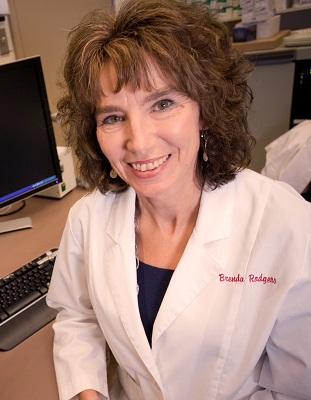Brenda Rodgers
Associate Professor
Email: brenda.rodgers@ttu.edu
Phone: 1(806)834-3232
Office: Biology 514
- Ph.D. Biology, Texas Tech University, Lubbock, TX (2000)
- M.S. Biology, Lamar University, Beaumont, TX (1997)
- B.S. Biological and Physical Sciences, University of Houston (1994, Cum laude)

Research Interests
- Role of environmental toxicants in activation/suppression of gene expression
- Genetic instability due to chronic, low-dose radiation exposure
- Sensitivity of vital demographic characters in populations exposed to environmental contaminants
- Evolutionary implications of chromosomal variation and evolution of radioresistance
- Human health effects from exposure to environmental toxicants
Selected Publications
- Rodgers, B. E., R. K. Chesser, and R. J. Baker. 2000. Genetic diversity of Clethrionomys glareolus from highly contaminated sites in the Chornobyl, Ukraine region. Environmental Toxicology and Chemistry19:2130-2135.
- Rodgers, B. E., J. K. Wickliffe, C. J. Phillips, R. K. Chesser, and R. J. Baker. 2001. Experimental exposure of naïve bank voles, Clethrionomys glareolus, to the Chornobyl, Ukraine environment: a test of radioresistance. Environmental Toxicology and Chemistry 20:1936-1941.
- Rodgers, B. E., R. K. Chesser, J. K. Wickliffe, C. J. Phillips, and R. J. Baker. 2001. Subchronic exposure of BALB/c and C57BL/6 strains of Mus musculus to the radioactive environment of the Chornobyl exclusion zone. Environmental Toxicology and Chemistry20:2830-2835.
- Torous, D.K. et al. 2001.Flow cytometric enumeration of micronucleated reticulocytes: High transferability among 14 laboratories. Environmental and Molecular Mutagenesis 38(1). 59-68.
- Wickliffe, J. K., R. K. Chesser, B. E. Rodgers, and R. J. Baker. 2002. Assessing the genotoxicity of chronic environmental irradiation by using mitochondrial DNA heteroplasmy in the bank vole (Clethrionomys glareolus) at Chornobyl, Ukraine. Environmental Toxicology and Chemistry21:1249-1254.
- Wickliffe, J.K., A.M. Bickham, B.E. Rodgers, R.K. Chesser, C.J. Phillips, S.P. Gaschak, and J.A. Goryanaya, I. Chizhevsky, R.J. Baker. 2003. Exposure to chronic low-dose radiation at Chornobyl does not induce point mutations in Big Blue mice. Environmental and Molecular Mutagenesis42:11-18.
- Chesser, R.K., M. Bondarkov, R.J. Baker, J.K. Wickliffe, and B.E. Rodgers. 2004. Reconstruction of radioactive plume characteristics along Chernobyl's Western Trace. Journal of Environmental Radioactivity 71:147-157.
- Meeks, H. N., J. K. Wickliffe, S. R. Hoofer, R. K. Chesser, B. E. Rodgers, and R. J. Baker. 2007. Mitochondrial control region variation in bank voles (Clethrionomys glareolus) is not related to Chernobyl radiation exposure. Environmental Toxicology and Chemistry26: 361-369.
- Rodgers, B.E. and K.M. Holmes. 2008. Radio-adaptive response to environmental exposures at Chernobyl. Dose Response6:209-221.
- Chesser, R.K. and B.E. Rodgers. 2008. Near-Field Radioactive Particle Dynamics and Empirical Fallout Patterns in Chernobyl's Western and Northern Plumes. Atmospheric Environment42:5124-39.
Department of Biological Sciences
-
Address
Department of Biological Sciences, Texas Tech University, Box 43131 Lubbock, TX 79409 -
Phone
806.742.2715 -
Email
biology@ttu.edu
